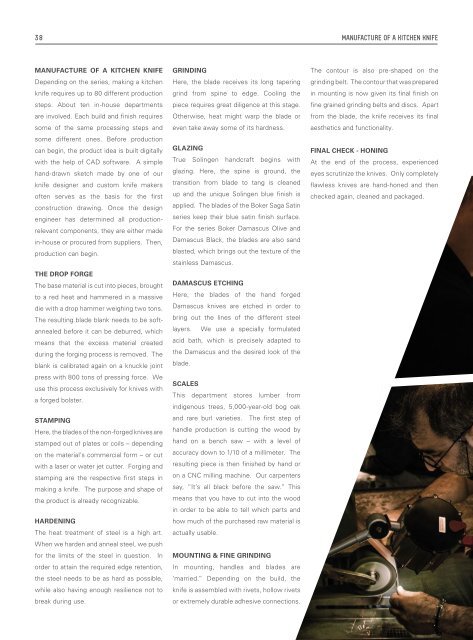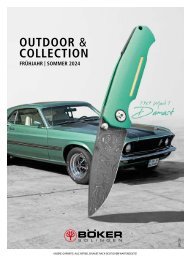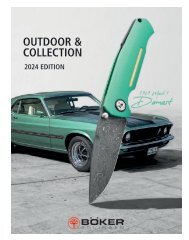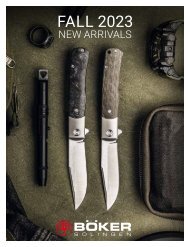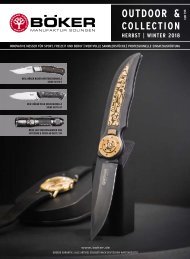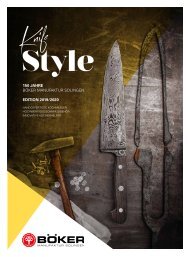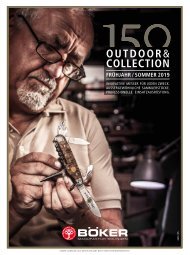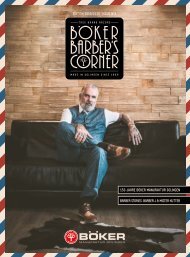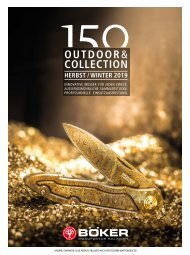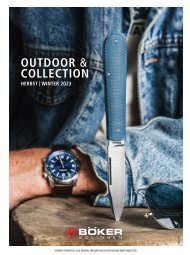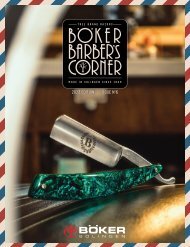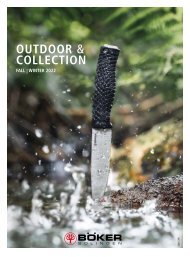Boker Knifestyle | EN Edition 2018 / 2019
Create successful ePaper yourself
Turn your PDF publications into a flip-book with our unique Google optimized e-Paper software.
38 MANUFACTURE OF A KITCH<strong>EN</strong> KNIFE<br />
MANUFACTURE OF A KITCH<strong>EN</strong> KNIFE<br />
Depending on the series, making a kitchen<br />
knife requires up to 80 different production<br />
steps. About ten in-house departments<br />
are involved. Each build and finish requires<br />
some of the same processing steps and<br />
some different ones. Before production<br />
can begin, the product idea is built digitally<br />
with the help of CAD software. A simple<br />
hand-drawn sketch made by one of our<br />
knife designer and custom knife makers<br />
often serves as the basis for the first<br />
construction drawing. Once the design<br />
engineer has determined all productionrelevant<br />
components, they are either made<br />
in-house or procured from suppliers. Then,<br />
production can begin.<br />
THE DROP FORGE<br />
The base material is cut into pieces, brought<br />
to a red heat and hammered in a massive<br />
die with a drop hammer weighing two tons.<br />
The resulting blade blank needs to be softannealed<br />
before it can be deburred, which<br />
means that the excess material created<br />
during the forging process is removed. The<br />
blank is calibrated again on a knuckle joint<br />
press with 800 tons of pressing force. We<br />
use this process exclusively for knives with<br />
a forged bolster.<br />
STAMPING<br />
Here, the blades of the non-forged knives are<br />
stamped out of plates or coils – depending<br />
on the material’s commercial form – or cut<br />
with a laser or water jet cutter. Forging and<br />
stamping are the respective first steps in<br />
making a knife. The purpose and shape of<br />
the product is already recognizable.<br />
HARD<strong>EN</strong>ING<br />
The heat treatment of steel is a high art.<br />
When we harden and anneal steel, we push<br />
for the limits of the steel in question. In<br />
order to attain the required edge retention,<br />
the steel needs to be as hard as possible,<br />
while also having enough resilience not to<br />
break during use.<br />
GRINDING<br />
Here, the blade receives its long tapering<br />
grind from spine to edge. Cooling the<br />
piece requires great diligence at this stage.<br />
Otherwise, heat might warp the blade or<br />
even take away some of its hardness.<br />
GLAZING<br />
True Solingen handcraft begins with<br />
glazing. Here, the spine is ground, the<br />
transition from blade to tang is cleaned<br />
up and the unique Solingen blue finish is<br />
applied. The blades of the <strong>Boker</strong> Saga Satin<br />
series keep their blue satin finish surface.<br />
For the series <strong>Boker</strong> Damascus Olive and<br />
Damascus Black, the blades are also sand<br />
blasted, which brings out the texture of the<br />
stainless Damascus.<br />
DAMASCUS ETCHING<br />
Here, the blades of the hand forged<br />
Damascus knives are etched in order to<br />
bring out the lines of the different steel<br />
layers. We use a specially formulated<br />
acid bath, which is precisely adapted to<br />
the Damascus and the desired look of the<br />
blade.<br />
SCALES<br />
This department stores lumber from<br />
indigenous trees, 5,000-year-old bog oak<br />
and rare burl varieties. The first step of<br />
handle production is cutting the wood by<br />
hand on a bench saw – with a level of<br />
accuracy down to 1/10 of a millimeter. The<br />
resulting piece is then finished by hand or<br />
on a CNC milling machine. Our carpenters<br />
say, “It’s all black before the saw.” This<br />
means that you have to cut into the wood<br />
in order to be able to tell which parts and<br />
how much of the purchased raw material is<br />
actually usable.<br />
MOUNTING & FINE GRINDING<br />
In mounting, handles and blades are<br />
‘married.” Depending on the build, the<br />
knife is assembled with rivets, hollow rivets<br />
or extremely durable adhesive connections.<br />
The contour is also pre-shaped on the<br />
grinding belt. The contour that was prepared<br />
in mounting is now given its final finish on<br />
fine grained grinding belts and discs. Apart<br />
from the blade, the knife receives its final<br />
aesthetics and functionality.<br />
FINAL CHECK - HONING<br />
At the end of the process, experienced<br />
eyes scrutinize the knives. Only completely<br />
flawless knives are hand-honed and then<br />
checked again, cleaned and packaged.


